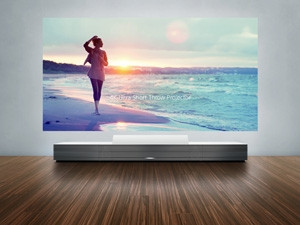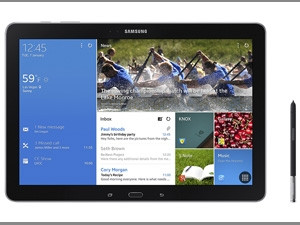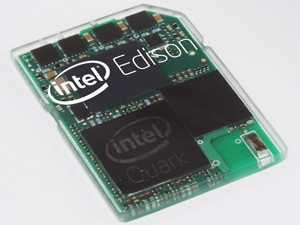
January is innovation season with the Consumer Electronics Show (CES), in Las Vegas, and everyone from manufacturing giants to tiny start-ups showcasing their latest developments. Like a fashion show, only a small part of what was on display will ever end up mainstream, but that does serve as a bellwether for what computing will look like, this year and next.
As expected, CES 2014 was heavily dominated by televisions and mobile computing, with a sprinkling of hardcore computing and a side-order of outright crazy, but even in the wilder tech prototypes there was some real value for computing professionals.
Most of all, there is a strong sense of evolution in the air - a steady march of progress as existing paradigms, like desktop computing, gradually give way to newcomers (mobile computing, in the case of desktops). We've had the big evolutionary leap forward, and what's happening now is a continuous refinement and a consolidation around accepted norms. And, as evolution goes, you get the occasional outlier - the freak of nature who must fit its niche or be weeded out.
At CES this year, there were some very strong evolutionary forces at play. Display technology is on a very strong footing, component manufacturers have some exciting new tricks up their sleeves, and tablet computing is seeing a profusion of innovation, which is probably a precursor to a more stable generation next year. (What about freaks of nature? They were there too: wearables.)
Among the products are some clear trends for business computing, and we can see glimpses of the future as they develop.
Innovation on display
Let's start with the TVs, because, while they're not immediately useful to us in computing, there are some important trends happening right there. Alongside the giant OLED screens on show from the usual suspects, notably LG, Samsung, Sony and Vizio, two key factors were on show: curved screens and Ultra High Definition (UHD).
Curved screens are often described as a gimmick - this season's 3D - with limited real-world appeal. But here's the thing: one of the detractions from a curved TV is that the optimum sitting distance, even for a big 70-inch screen, is about six feet. That's way too close for a living room, but scale it down and what you get is a perfect form factor for multi-monitor configurations on a desktop. Graphic designers, film pros and developers all stand to benefit from more ergonomic displays, especially when we consider the other big push: UHD.
UHD is exactly double full HD in both dimensions - 3840x2160, with four times the pixels. And it's a sure bet, unlike 3D. All the TV manufacturers are trumpeting their new UHD screens, and content producers are coming to the party - Netflix has declared that all its new content will be filmed in UHD. The industry has adopted the term "4K" for these displays, and while that's actually a mistake - 4K is a production standard with a different display format - it'll stick. 4K/UHD will be the next display standard, content will come, and consumers will demand screens capable of displaying the content natively.
Right now, there are relatively few monitors, a very small number of laptop screens, and no tablets at all capable of handling UHD resolution. Apple's iPad Retina display, the darling of the industry when it debuted, is a fraction of the density required for UHD content. So we'll get new displays in every form factor, and that will drive a new wave of products, while pushing legacy prices down. That will reverse a trend that began several years ago: screen resolution actually halted and went into decline as consumers were demanding focus on HD content. So we saw higher resolutions relegated to graphic design and gaming niches, and the market consolidated around the media-friendly 16:9 ratio, unfortunately sub-par for computing. We won't change the ratio now - media consumption is decidedly the driving factor for display technology now - but we will start to see resolutions picking up. Dell already has a 5x HD laptop - the XPS 15, with 3200x1800 resolution - in the market, for example.
At CES, Sony also debuted a UHD short-throw projector, intended for boardrooms, capable of projecting an image up to 147 inches, while nestled up against the receiving wall.
We'll also see a new push in tablet and phone displays. UHD is beyond the reach of tablet computing today - most mid-range devices can handle HD or better, but the iPad tops out at 2048x1536, with Google, Samsung and Acer offering models reaching 2560x1600 - still some way off full UHD. And while content will look just fine scaled down to that size, there will be a definite marketing advantage to the first manufacturer able to claim "UHD" for its products.
Tablet innovation and fragmentation
What that will mean is further bifurcation of the tablet market. CES already showed this, with high-end tablets alongside cheap entry-level devices. Samsung has made it official, with the d'ebut of a "Pro" range aiming at the top end of the market. IT departments will inevitably have to support a wider range of capabilities, but in the workplace the trend should continue towards more powerful devices, allowing more advanced apps and making further inroads as desktop replacements. The Galaxy Note Pro, besides the segmentation, is notable for other directions - it is very large, at 12.2 inches (though it does have smaller versions - eight- and 10-inch). And it features a radically redesigned interface more akin to Windows' live tiles than the traditional Android experience.

The size is interesting, but not itself exceptional: very large tablets hit the market last year - Dell and Asus both have giant 18-inch models that are probably solutions looking for a problem, and there is some interest growing in convertibles: all-in-one PCs that can switch between a PC OS (usually Windows 8) and Android, either via a separate on-board chipset with some storage-sharing trickery, or hosted in a VM.
More realistically, the big tablet space is settling around the 11- to 12-inch mark where, armed with keyboard shell and peripheral support, it's a definite competitor to the ultra-portable notebook. Although some Android devices will target this space, it's more probably Microsoft Windows that will stake out a claim on desktop replacements.
But small tablets are also starting to look like viable desktop replacements, courtesy of more capable docking stations. Late last year, Dell showed off its Venue 11 Pro - an 11-inch Windows 8.1 tablet designed to be slipped into a docking station with external screens, keyboard and mouse. That slipstreaming of tablet mobility into fully-fledged workplace desktop computing has the potential to open a lot of opportunities.
Back to Samsung, the other highlight of its Galaxy Note Pro was the interface, dubbed "Magazine UX", which offers multiple tiles and looks remarkably reminiscent of Windows. Notably, right now only Samsung's native apps support the multi-window environment, and it's very possible that Samsung is looking to establish an ecosystem of its own alongside Android. The company operates its own app store, and is strengthening its play into the corporate world through its KNOX and SAFE security technologies. Samsung may be setting the scene for an outright defection - the company has been keeping quiet about its plans for Tizen, its Linux-based OS for mobile devices. Samsung has a dominant position in Android phones, and a strong position in tablets, and a migration to Tizen would ring-fence its user base. The Galaxy S5 phone is due later this year, and analysts will be watching that launch closely for signs of fence-building.
Samsung is unlikely to split away from Android - parallel product lines are more likely, but the Galaxy Note Pro does seem to hint at a parting of ways. And that is not going to be welcome news for enterprise IT, SAFE or no SAFE - it would mean yet another platform to support.
Elsewhere, the tablet market continues to fragment. Mobile computing is undergoing a phase of design turmoil reminiscent of the 90s. Remember the profusion of notebook designs? We had the swappable drive bay/battery combinations, the trackballs giving way to track pads, built-in AC adapters, built-in mice, weird hotkey placements, shape-shifting keyboards and rotating screens... you name it. Eventually it settled down to the familiar configurations we see today, and for several years that's more or less where we've stayed. Tablets have brought that flurry of innovation back, and now we have phones that dock into tablets, giant table-sized tablet devices that dual boot Windows as a PC and Android as a tablet, bendy screens, wearable interfaces, phablets... It'll settle down in due course (and Apple's minimalist elegance is probably a safe guide of the ultimate direction for at least some categories) but right now it's challenging for the vendors to know where to place their bets, and difficult for the market to keep up.
Some are clearly design prototypes not intended for mass market or desperate attempts to "stick", and some are predestined for niche positions, but trends like wearable computing are not only interesting, because they're carving out new product categories, but because they are going to reshape the rest of the technology space around them.
Processors and memory are cool again
Less glamorous, but possibly more interesting to technologists, were the new components on show. AMD and Intel both demonstrated reference designs based on their newest system on a chip (SoC) designs. In AMD's case, that was the svelte Nano PC, powered by the firm's Mullins accelerated processing unit (APU). The Nano is aimed at home theatres, but grabbed interest for its low-power, highly-integrated package. No bigger than a paperback, it's the sort of power- and space-saving innovation enterprise IT likes to see. Intel, meanwhile, took downsizing to a whole new level with Edison, a fully capable PC the size of an SD card, complete with storage, WiFi and the rest, powered by the 22nm Quark CPU. The Edison is aimed at the wearable market, but also shows how far the manufacturers are pushing consolidation and power reduction.

Low power was also the highlight of the DDR4 announcement. Intel has announced it will start shipping DDR4 systems this year, with several manufacturers showing modules. DDR4, not to be confused with GDDR4 in graphic cards, will bring faster performance and major power improvements to the RAM space, initially benefiting server platforms. High-density server rooms will benefit, but since DDR4 will require a motherboard and CPU upgrade to realise the benefits, it'll be a gradual improvement.
Mobile phones? What mobile phones?
2012 saw a healthy crop of new mobile phones, notably the d'ebut of Nokia's Lumia range and its PureView optics.
This year, there was virtually dead silence from the phone manufacturers, all of which are hosting big splashy events of their own as the smartphone market hits what may be the peak of its hype cycle. There were a few new devices, but the only real standout was Sony's Xperia Z1 Compact, which, despite its name, still offers a 4.3-inch screen on top of its quad-core processor and 20MP camera.
If anything can be deduced from the dearth of high-end smartphones at CES, it's that manufacturers are desperate for differentiation, hosting their own shows - probably a good sign for users - and that the baseline for what qualifies as a high-end mobile device continues to rise at breakneck pace. The idea that anyone would market a 4.3-inch screen as a "compact" variant would have been unthinkable a generation ago.
Wear it on your sleeve
CES predictably saw another slew of wearables on display, and, as expected, they failed to impress many commentators. Most of the general-purpose wearables are disappointingly underpowered while the vendor-specific offerings are too limited.

Only the fitness segment is showing any signs of traction right now (since divers and runners have effectively had wrist-mounted computers for years), but with big mobility players showing interest, it's equally possible that, within a very short time frame, we'll have more generic external interfaces supported as standard, whether that's a watch, dashboard display or heads-up display.
And that may draw the hype out of wearables in one fell swoop. CES 2015 may be a lot less wearable and a lot more practical.
Evolution with purpose
Although some of the technologies are evolving more erratically than others, notably in the tablet/mobile computing sectors, most of the technology trends are shaping up with intent, whether that is to improve energy efficiency, or deliver a new generation of content, or facilitate specific apps.
Whether we're taking the role of consumer or IT professional, your technology strategy for 2014 should similarly be aligned with intent, and measured as fit for purpose against a key goal. But not, of course, an end goal - evolution is a continuous process, after all.
Share